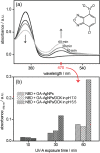Gallic acid-coated silver nanoparticles as perspective drug nanocarriers: bioanalytical study
- PMID: 35294597
- PMCID: PMC8923963
- DOI: 10.1007/s00216-022-03955-2
Gallic acid-coated silver nanoparticles as perspective drug nanocarriers: bioanalytical study
Abstract
The ability of silver nanoparticles (AgNPs) to be used as drug nanocarriers has helped rapidly to invent novel strategies to treat diseases, such as cancer. The nanoparticles may offer a valuable tool to novel pH-sensitive drug delivery systems in the present scenario because of their undergoing mechanisms associated with the regulated dissolution, aggregation, and generation of oxygen radicals as well. These processes could be monitored by electrochemical (bio)sensors that are less money and time-consuming compared to other analytical approaches, however, with comparable analytical performance. In this paper, synthesized and microscopically characterized gallic acid-coated AgNPs (GA-AgNPs) are investigated using spectral and electrochemical methods. To investigate the Ag+ release, a 21-day ageing experiment is performed spectrophotometrically, finding that the peak maximum of GA-AgNPs spectra diminished by 24.5%. The highest Ag+ content was electrochemically determined in the supernatant solution after centrifugation (6.97 μmol·L-1), while no significant concentration of silver ions in solution after redispersion was observed (1.26 μmol·L-1). The interaction experiment indicates a stabilization of GA-AgNPs in the presence of long-chain dsDNA as well as a mutual electrostatic interaction with DNA sugar-phosphate backbone. This interaction mechanism is confirmed by FTIR analysis, showing a shift (1049 to 1061 cm-1 and 913 to 964 cm-1) specific to DNA phosphate bands. Finally, doxorubicin-loaded GA-AgNPs are monitored for the specific drug release in the physiological and more reactive weakly acidic microenvironment. Hereby, electrochemical (bio)sensing of GA-AgNPs undergoing mechanisms shows a huge potential to be used for monitoring of drug delivery systems at cancer therapy.
Keywords: Aggregation; DNA interaction; Drug delivery system; Electrochemical biosensor; Silver ion release; Silver nanoparticles.
© 2022. Springer-Verlag GmbH Germany, part of Springer Nature.
Conflict of interest statement
The authors declare no competing interests.
Figures






References
-
- Mandal AK. Silver nanoparticles as drug delivery vehicle against infections. Glob J Nanomedicine. 2017;3(2):555607.
-
- Ravindran A, Chandrasekaran N, Mukherjee A. Studies on differential behavior of silver nanoparticles towards thiol containing amino acids. Curr Nanosci. 2012;8(1):141–149. doi: 10.2174/157341312799362331. - DOI
-
- Li D, Liu Z, Yuan Y, Liu Y, Niu F. Green synthesis of gallic acid-coated silver nanoparticles with high antimicrobial activity and low cytotoxicity to normal cells. Process Biochem. 2015;50(3):357–366. doi: 10.1016/j.procbio.2015.01.002. - DOI
MeSH terms
Substances
Grants and funding
LinkOut - more resources
Full Text Sources
Other Literature Sources

